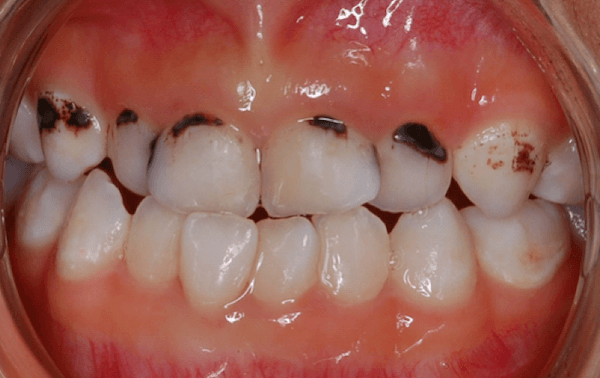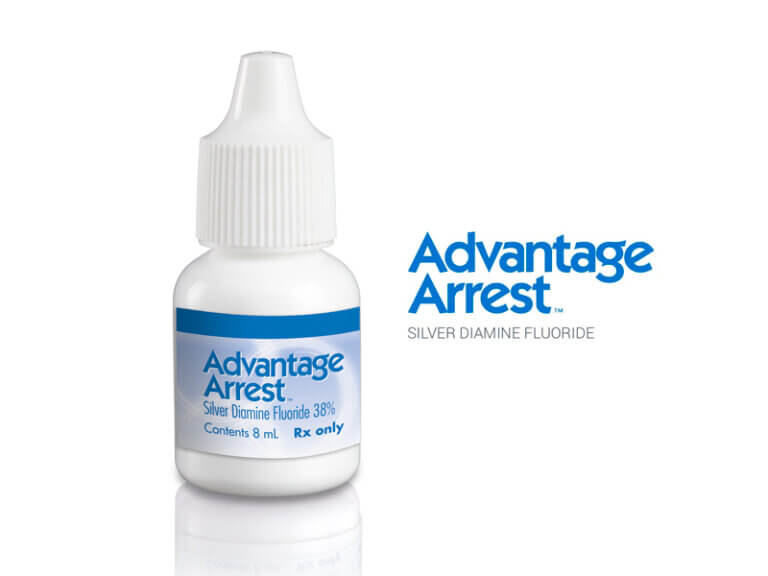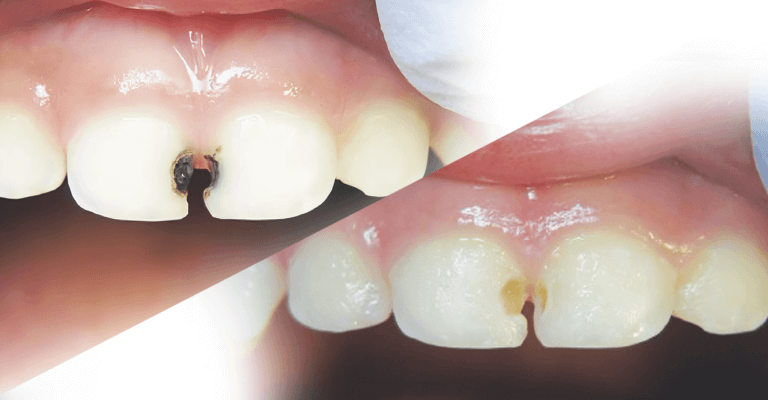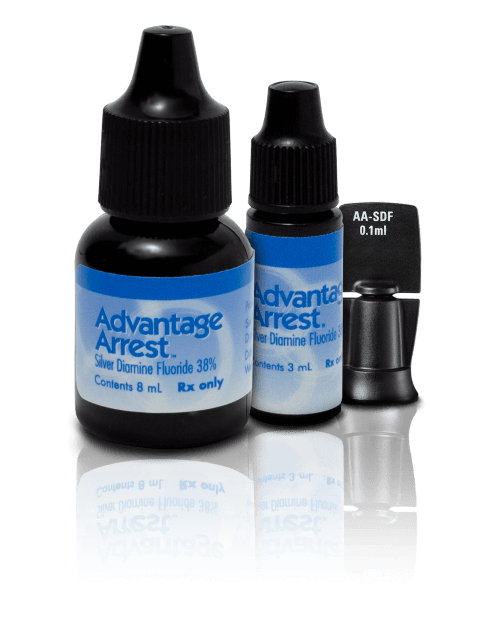Silver Diamine Fluoride

What Is Silver Diamine Fluoride?
Silver Diamine Fluoride (SDF) is a liquid substance used in dentistry to treat and prevent cavities. It is composed of four key ingredients:
- Silver: Acts as an antibacterial agent.
- Fluoride: Helps strengthen tooth enamel.
- Ammonia: Stabilizes the solution.
- Water: Serves as a solvent.
When applied to decayed teeth, SDF works by halting the progression of cavities, protecting teeth from further damage, and even preventing new cavities from forming. It’s particularly popular among children, elderly patients, and individuals with dental anxiety because it eliminates the need for drills or needles.
Popular brands include Riva Star (SDI) and Advantage Arrest (Oral Science), widely trusted for caries management. Before deciding on whether Silver Diamine Fluoride are right for you, there are some things you should know:
- Who Can Benefit from Silver Diamine Fluoride?
- Advantages Of Silver Diamine Fluoride
- Potential Risks Or Complications Of Silver Diamine Fluoride
- Alternative Treatments To Silver Diamine Fluoride
- How Much Does Silver Diamine Fluoride Cost?
- Steps In The Silver Diamine Fluoride Procedure
- Frequently Asked Questions About Silver Diamine Fluoride
If you have any further questions about Silver Diamine Fluoride or other dental services offered at Atlas Dental, please contact us.

Free phone consultation
Have questions about Silver Diamine Fluoride? Schedule a free phone consultation with our Toronto dentist.

5 star google reviews
Our patients love us! See for yourself why more and more people are choosing Atlas Dental for SDF treatment.

Book consultation and treatment
Do you think you have cavities and need an appointment? Schedule an in-person consultation and treatment.
Who Can Benefit from Silver Diamine Fluoride?
SDF is an excellent option for many patients, including:
- Children with cavities: Especially beneficial for children who have difficulty sitting through traditional dental procedures.
- Elderly patients: A suitable solution for individuals with limited mobility or complex medical conditions.
- Patients with dental anxiety: A painless and non-invasive alternative for those who fear traditional dental treatments.
- People with special needs: Makes dental care more accessible for individuals with cognitive or physical impairments.
- High-risk cavity patients: Ideal for those prone to cavities due to conditions like dry mouth, poor oral hygiene, or a sugary diet.
By addressing the needs of these diverse patient groups, Silver Diamine Fluoride helps to make dental care more inclusive and effective. If you have further questions about Silver Diamine Fluoride, please contact us.

What Are The Advantages Of Silver Diamine Fluoride?
SDF has gained popularity for several reasons:
- Non-invasive: No drilling or needles are required.
- Painless and quick: Treatment takes only minutes to complete.
- Cost-effective: More affordable than traditional fillings or crowns.
- Prevents further decay: Strengthens enamel and stops cavity progression.
- Accessible: A great option for underserved populations with limited access to dental care.
By providing these advantages, Silver Diamine Fluoride enhances the ability of dental professionals to manage caries effectively while improving patient comfort and satisfaction. If you have further questions about Silver Diamine Fluoride, please contact us.

What Are The Potential Risks Or Complications Of Silver Diamine Fluoride?
While SDF is safe and effective, patients should be aware of potential drawbacks:
- Permanent discoloration: Treated cavities turn black, which may be noticeable on front teeth.
- Temporary gum staining: Accidental application on gums can cause temporary discoloration.
- Allergic reactions: Rare but possible, especially for individuals allergic to silver.
- Not suitable for severe decay: Advanced cavities that reach the pulp require more invasive treatments, such as root canals.
Understanding these potential risks and complications helps dental professionals provide comprehensive patient education and make informed decisions about the use of Silver Diamine Fluoride in dental care. If you have further questions about Silver Diamine Fluoride, please contact us.
Alternative Treatments To Silver Diamine Fluoride
If SDF isn’t the right fit for you, consider these alternatives:
- Fluoride varnish: Helps prevent cavities without staining.
- Composite fillings: Tooth-colored fillings for aesthetic and functional restoration.
- Glass ionomer fillings: Releases fluoride to protect teeth while filling cavities.
- Dental crowns: Covers and protects teeth with extensive damage.
Discussing these alternatives with your dentist can help you make an informed decision about the best treatment option for your specific situation, ensuring that you receive the most appropriate and effective care for your dental health needs. If you have further questions about Silver Diamine Fluoride, please contact us.

Cost of Silver Diamine Fluoride Treatment
Silver Diamine Fluoride application costs $74. The codes relevant to SDF treatment in the Ontario Dental Association’s Suggested Fee Guide appear as follows:
Topical Application to Hard Tissue Lesion(s) of Antimicrobial or Remineralization Agent
- 13601 – One unit of time (15 minutes): $74.00
SDF treatment is generally considered a basic service under all dental insurance plans and should be covered to your maximum insurable limit, but be sure to find out from your dental insurance plan provider how much you are eligible for before going ahead with dental treatment. Our fees are consistent with the ODA Fee Guide.
For patients without dental insurance, Atlas Dental is pleased to offer dental financing through iFinance Dentalcard. Affordable payment plans start at 7.95% for terms of 6 months to 6 years. To learn more about Dentalcard dental treatment financing, follow this link.
Steps In The Silver Diamine Fluoride Procedure
Here’s what to expect during an SDF treatment:
- Assessment: The dentist examines your teeth and confirms suitability for SDF.
- Preparation: The tooth is cleaned and isolated to ensure effective application.
- Application: SDF is carefully applied to the affected tooth using a small brush.
- Setting: The solution is allowed to penetrate for 1–3 minutes before rinsing.
- Post-care: Patients receive instructions on oral hygiene and follow-up care.
By following these steps, dental professionals can efficiently apply Silver Diamine Fluoride to manage dental caries and improve patients’ oral health outcomes. If you have further questions about Silver Diamine Fluoride, please contact us.

Frequently Asked Questions About Silver Diamine Fluoride
- Does SDF hurt during application?
No, SDF is a painless procedure. Patients typically feel no discomfort during or after treatment.
- Can SDF completely restore my tooth?
SDF halts tooth decay but does not restore the tooth’s structure. For aesthetic or functional concerns, additional treatments like fillings may be needed.
- How long does SDF last?
The effects of SDF can last up to 6–12 months. Regular dental check-ups ensure its continued effectiveness.
- Can SDF be used on visible front teeth?
Yes, but patients should note that SDF stains decayed areas black, which may affect aesthetics. Discuss alternatives with your dentist for visible teeth.
At Atlas Dental, we prioritize your comfort and oral health. Don’t let cavities affect your smile. Contact us today to learn more about SDF or other dental services.

